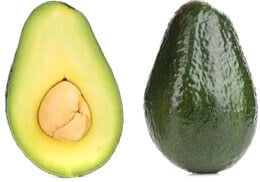Dietary fiber is a type of carbohydrate that is not able to be digested but is essential to the body. Numerous studies have shown that adequate fiber consumption can help to reduce the risk of obesity, type 2 diabetes, heart disease and certain cancers. It can also help with weight management and prevention of constipation. In fact, a 2019 study found that for every 8g increase of dietary fiber eaten per day, total deaths and incidence of coronary heart disease, type 2 diabetes and colorectal cancer decreased by 5-27%.
There are two main types of fibers found in foods. These are soluble (swells in water) and insoluble (does not swell in water). Both are critical for good health and both are best obtained through food. I tell my patients to avoid any food that has been stripped of fiber (like juice, white bread, etc.) and to always look for a more bang for your nutrition buck whenever you can. That means keeping those skins on your apples and throw some seeds into that salad.
Fiber also plays a major role in improving gut health. A 2020 study found that diet and gut health were directly related and that foods rich in fiber had a beneficial impact on the gut microbiome. One of the biggest impacts of fiber on the gut is that the gut microbiome converts fiber into short chain fatty acids through fermentation. Short-chain fatty acids, or SCFAs, are the main source of energy for the cells lining the colon. SCFA are very important for colon health and in the prevention of intestinal disease. It is really easy to get sufficient amounts of fiber if you just follow a healthy diet that includes lots of green leafy vegetables, beans, berries, and grains. Here are 10 Ways to use fiber to fight heart disease and obesity using foods to consume to get your daily dose of fiber.
 1. Blackberries
1. Blackberries
Blackberries are one of the best berries the body can get. In addition to its fiber content, blackberries boast the deepest hue’s in the berry family. Studies show that the deeper the color or hue of a plant, the more anthocyanins it provides and thus, the more benefits. Though all berries provide benefit (especially to the brain) blackberries have that extra boost of color that may yield added benefit.
 2. Oats
2. Oats
Oats provide a double whammy of fiber benefit since they contain both soluble (the oat) and insoluble (the husk) fiber. That means oats can help to move bulk out of the body AND help to lower cholesterol as well. Further, though ready to eat cereal are often high in fiber as well, oats (oatmeal) beat them out in a study showing that they were superior in controlling appetite and thus weight. They also don’t have the added sugar that many cereals tend to have.
 3. Popcorn
3. Popcorn
6g of fiber per 2 TBS raw popping corn
Popcorn not only provides a great content of fiber, it’s also one of the highest antioxidant snacks you can get. In fact one study found that popcorn may have more antioxidants than some fruits and vegetables. The key to enjoying popcorn is to air pop, or use avocado or coconut oil on the stove and adding in nutrient dense ingredients, such as drizzle of olive oil and some cinnamon or turmeric.
 4. Navy beans
4. Navy beans
Beans and lentil are the powerhouses of fiber content, providing a huge amount in a small serving. Additionally, beans have been identified as a major player in helping to reduce the risk of heart disease.
 5. Avocado
5. Avocado
Who doesn’t love some guacamole on top of a taco or corn chip? OR – having some eggs in avocado boats. Avocados are a healthy source of fat with good fiber components. Studies show that avocados can help in management of weight and blood sugar.
 6. Pistachios
6. Pistachios
Pistachios are a great snack, especially if you want to get some crunch and satisfaction without carbs. Pistachios have been found in studies to help in the reduction of stress, reduce cholesterol, help with weight loss and perhaps may have more antioxidants than other nuts. In terms of gut health, some studies suggest that pistachios are better than other nuts for gut health.
 7. Lentils
7. Lentils
Lentils have similar benefits to other beans (reduce the risk of heart disease, manage weight) but a 2019 study found that replacing potatoes or rice with lentils could result in a significant improvement in blood sugar control. The study found that lentils may inhibit enzymes involved in the process of absorbing glucose.
 8. Collard greens and 9. Brussel sprouts
8. Collard greens and 9. Brussel sprouts
Collard greens are one of my favorite foods to recommend to patients since they happen to be one of the best sources of plant-based calcium. They are also easy to throw in a casserole, soup or even eggs in the morning since they wilt down. Collards have also been associated with improvements in eye health, as well as reducing the risk for colon cancer. Brussel sprouts, another cruciferous veggie, are a great source of prebiotics. Prebiotics help probiotics flourish, and thus, help to improve overall gut health.
 10. Almond flour
10. Almond flour
When considering the best ways to get fiber, don’t forget about flours. Almond flours have one of the best combinations of high nutrient, low carb and high fiber. In addition, it’s a great source of vitamin E and magnesium.
In today’s SAD American Diet, dietary fiber can be in minimal existence due to the reliance on processed food, take out dining, and diets heavy in simple carbohydrates. Lack of dietary fiber can but you at risk for metabolic disease, intestinal disorders and unnecessary weight gain. Fortunately, you can easily prevent these health issues with adding high fiber foods to each meal. Feed those gut bacteria properly and they will help you enjoy the vibrant health you deserve!













